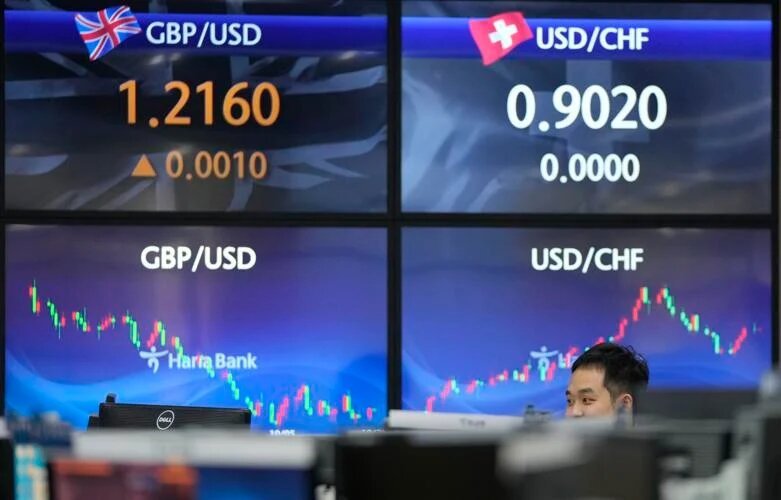While investors wait for the US Federal Reserve to make a decision on interest rates, global equities are split and oil prices have increased.
On Tuesday, October 31, 2023, in the foreign exchange dealing room of the KEB Hana Bank headquarters in Seoul, South Korea, a currency trader goes by the screens displaying the Korea Composite Stock Price Index (KOSPI), centre, and the foreign exchange rate between the U.S. dollar and South Korean won, right. As investors anticipated a week that would see additional fluctuations in financial markets, including important reports on U.S. consumer confidence and the job market, Asian shares were mainly down on Wednesday.
After the Bank of Japan modified its language about government bond yields, allowing yields on 10-year bonds to grow over 1% and referring to it as “a reference point” rather than a more strictly imposed cap, the value of the Japanese yen fell versus the US dollar.
However, the long-standing benchmark interest rate of minus 0.1% was maintained by the central bank. In contrast to the US Federal Reserve and other major central banks, which have been tightening their monetary policies in an effort to combat inflation, it is moving in an opposite direction.
As a result, the value of Japan’s exporters’ foreign profits has increased in local currency due to the sharp decline in the value of the Japanese yen. The dollar increased from 149.10 Japanese yen to 150.40 yen on Tuesday.
Early European trade saw a 0.1% increase to 6,832.45, on France’s CAC 40. The DAX in Germany increased by over 0.1% to 14,730.61. The FTSE 100 in Britain increased 0.1% to 7,334.64.
The S&P 500’s future increased by 0.1%, whereas the Dow Jones Industrial Average’s increased by 0.3%. The Dow Jones Industrial Average increased 1.6% and the S&P 500 increased 1.2% on Monday. 1.2% was added to the Nasdaq composite.
Tokyo’s Nikkei 225 gained 0.5% to close at 30,858.85 in Asian trading. S&P/ASX 200 in Australia increased by 0.1% to 6,780.70. The Kospi of South Korea fell 1.4% to 2,277.99. The Shanghai Composite fell by almost 0.1% to 3,018.77, while Hong Kong’s Hang Seng fell 1.7% to 17,112.49.
The US government will make data on employment costs for the months of July through September available on Tuesday. Although workers have been pushing for raises, the Fed is concerned that excessive wage growth may lead to further inflation. The Conference Board will also make available its October consumer confidence index.
The Federal Reserve’s policy announcement and an update on the quantity of job opportunities nationwide are scheduled for Wednesday. If the number of job vacancies declines without necessitating waves of layoffs, the Federal Reserve may be able to pull off the difficult balancing act of slowing the economy without starting a recession.
The jobs report for October, which is usually one of the most anticipated pieces of economic data each month, will be released on Friday.
Reports on profits are also forthcoming from about 150 S&P 500 businesses. This includes Apple’s most recent quarterly report, which is due on Thursday. It is the most significant stock on the S&P 500 as well as the most valuable stock on Wall Street.
In other transactions on Tuesday, the New York Mercantile Exchange’s benchmark U.S. crude saw a 64-cent increase to $82.95 a barrel in electronic trading. On Monday, it dropped 3.8% to $82.31. The global benchmark, Brent crude, increased by 72 cents to $87.07 a barrel.
The euro increased from $1.0617 to $1.0641.
All rights reserved. Associated Press, 2023 Reserved rights apply. It is prohibited to publish, broadcast, rewrite, or distribute this content.







